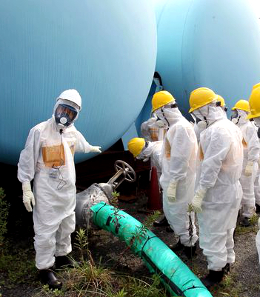TEPCO yet to reveal tank plan
 Japanese authorities have no official plan for what to do with more than 1 million tonnes of radioactive water at the Fukushima nuclear power plant.
Japanese authorities have no official plan for what to do with more than 1 million tonnes of radioactive water at the Fukushima nuclear power plant.
As the seventh anniversary of the Fukushima Daiichi nuclear disaster looms, Tokyo Electric Power Company (TEPCO) says it has slowed the rate of contaminated water reaching the reactor facilities, but the amount is still increasing.
“A few years ago [the radioactive water was increasing by] 400 tonnes per day, but the increase per day has now gone down to around 100 tonnes per day,” says Naohiro Masuda, TEPCO's chief decommissioning officer.
“A few years ago we had to create one new tank every two or three days but now we need to increase one new tank every seven to 10 days, so in that sense we think it is progress, to a certain degree, in the sense it is a more stabilised situation,” he said.
There are currently over 1,000 tanks of contaminated water at the site.
Government authorities have not announced any official plans for what to do with the water.
A US$300 million underground frozen soil wall — intended to be the main defence against groundwater contamination — has had only a limited effect.
One idea remaining is to decontaminatie the water as much as possible and then gradually release it into the Pacific Ocean.
Satoru Toyomoto from the Japanese Ministry of Economy, Trade and Industry says the Government sub-committee is considering its options.
“You may think after as many as seven years [this should be decided], but we have done our utmost and we have done all possible things and we have finally come to a stage where we can consider this,” he told reporters.
“After the accident occurred [in 2011] it was like a field hospital on a battlefield — but finally we have reached a situation where we can calmly think about the long-term future.
“A taskforce two years ago considered various options including geological disposal, vaporisation, burial underground, hydrogen release or release into the sea.
“Of those five options, we are trying to make a comprehensive assessment looking at options, but also reputational measures.”







 Print
Print